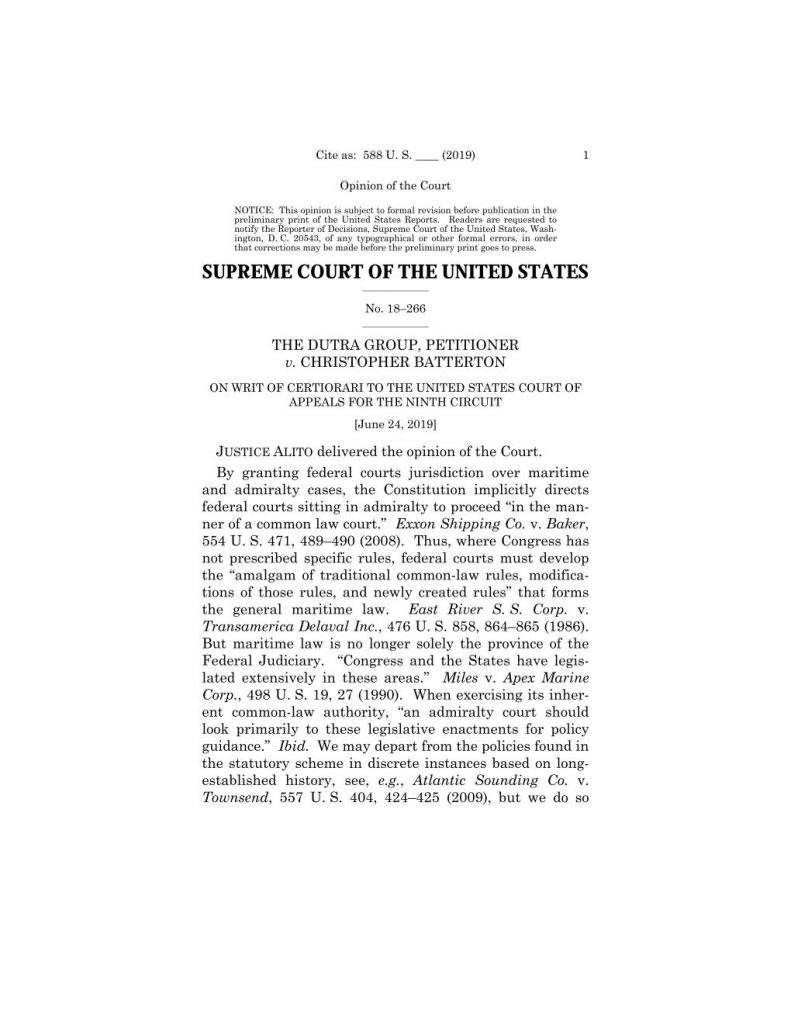THE DUTRA GROUP v BATTERTON
139 S.CT 2275 (2019)
Opinion of the Court
SUPREME COURT OF THE UNITED STATES
No. 18-266

SCOPE OF MARITIME DAMAGES
Is the scope of damages for an action brought under both the Jones Act and general maritime law bound by Congressional action or the common law? Are punitive damages allowed under general maritime law but not the Jones Act? Have they ever been? Can punitive damages be sought for injuries, but not death? Are seamen still entitled to “special solicitousness”, and if so, how does that affect their scope of damages?
The voyage to these answers has been one through turbulent seas. State Trial courts, state Appellate Courts, Federal Trial Courts, and Federal Appellate Courts have all tackled the issues, and now, the United States Supreme Court has spoken. A final answer has come forth. EPS litigated and kept alive the punitive damage issue under general maritime law at each and every one of these aforementioned levels, until Certiorari was granted in the EPS matter herein, with the final word now issued in the June 24, 2019 Opinion of the United States Supreme Court.
THE DUTRA GROUP v BATTERTON
The matter involves a lawsuit brought by an injured crew member (Batterton) against his vessel owner employer (Dutra), in which negligence under the Jones Act, breach of the duty of seaworthiness, and breach of the duty of maintenance and cure, were alleged. On behalf of the employer, in 2014 EPS moved to strike the punitive damages claim on the grounds that punitive damages are not available in an unseaworthiness action based upon the United States Supreme Court case of Miles v Apex Marine, and in light of the recent 5th Circuit en banc decision in McBride v Estis Well Service. The USDC denied the Motion to Strike, but certified the interlocutory appeal sought under 28 U.S.C Section 1292(b). As the matter was proceeding on an interlocutory manner prior to the conclusion of the underlying litigation, permission to appeal was requested to the 9th Circuit Court of Appeals, and was granted. The 9th Circuit Court of Appeals heard the matter and affirmed the USDC decision, relying on a prior 9th Circuit case, Evich v. Morris, which the Court indicated was not overruled by Miles as Dutra had contended. Additionally, the 9th Circuit panel indicated that even if not bound by Evich, they were of the opinion that this matter was more closely aligned with the Supreme Court opinion in Atlantic Sounding v Townsend, which allowed punitive damages in matters of maintenance and cure.
The 9th Circuit panel did, however, chart a clear causeway to SCOTUS certiorari grant in their opinion. Disputes with the 5th Circuit were set forth and the request for SCOTUS intervention made clear. As an example, the 9th Circuit decision stated: “It is also true, as Dutra argues, that if we were to interpret Miles broadly and Townsend narrowly, as the Fifth Circuit has in McBride, then we might infer that Miles implicitly overruled Evich. …The Fifth Circuit’s leading opinions in McBride are scholarly and carefully reasoned, but so are the dissenting opinions, which to us are more persuasive.” (Opinion at p.16) With their stated preference for the dissent from the 5th Circuit, and their conflict with the majority, the 9th laid bare the Circuit split.
SUPREME COURT
Miles v Townsend? Congressional adherence or common law action? Is there actually a history of punitive damages as contended? Is special solicitousness for seaman still a thing? If so, what is its effect on scope of damages? Joined with Supreme Court co-counsel Wilmer Hale, EPS addressed these issues, which were decided by the Court in a 6-3 vote, authored by Justice Alito, reversing the 9th Circuit. The Court has now declared that a Plaintiff seaman may NOT recover punitive damages on a claim of unseaworthiness.
The Court’s decision notes a number of bases supporting its holding:
- Miles v Townsend? Uniformity and/or History
The quest for uniformity, spelled out in Miles, weighed heavy on the Court’s reasoning. The Townsend historical approach for additional or “novel” remedies did also get its due consideration; however, its consideration appeared in the scope of allowance only where uniformity would not be violated.
The Court ultimately did not frame its Opinion as a choice between the uniformity requirement in Miles and the historical analysis in Townsend, but rather explained that “resolution of this question is governed by our decisions in Miles and Atlantic Sounding [Townsend]” (emphasis added). The Court further explained, “we cannot sanction a novel remedy here unless it is required to maintain uniformity with Congress’s clearly expressed policies. Therefore, we must consider the remedies typically recognized for Jones Act claims.” Because the Jones Act adopts the remedial provisions of FELA, the Court looked to the Jones Act, FELA, and judicial interpretations thereof to determine the nature and scope of remedies allowed. In so doing, the Court repeatedly identified compensatory, but not punitive, damages as the available remedy. In other words, what Batterton sought “would be contrary to Miles’s command that federal courts should seek to promote a ‘uniform rule applicable to all actions’ for the same injury, whether under the Jones Act or the general maritime law.”
Miles’ uniformity is to be considered in evaluating any statutory scheme. The Court noted it should “look to …legislative enactments for policy guidance”, while recognizing that the Court “may supplement these statutory remedies where doing so would achieve uniform vindication”. Novel remedies must not be sanctioned “unless it is required to maintain uniformity with Congress’ clearly expressed policies”.
Often posed as a choice between the Miles’ uniformity analysis or the Townsend historical analysis, the Court endeavored to eliminate that conflict. The Court emphasized that when they allowed punitive damages in Townsend, “we justified our departure from the statutory remedial scheme based on the established history of awarding punitive damages for certain maritime torts, including maintenance and cure.” Townsend did not supplant Miles. Townsend “represented a gloss on Miles rather than a departure from it.” As declared in Townsend, “The reasoning in Miles remains sound.”
2. The evolution of the unseaworthiness cause of action
In considering both uniformity considerations and the history of certain remedies, the Court detailed the progression of unseaworthiness from an “obscure and little used remedy” to what it is today. “Severe” limitations initially existed with regard to unseaworthiness, including the fellow-servant doctrine, prohibiting recovery when an employee suffered an injury due to the negligence of another employee without negligence on behalf of the employer, which led to its little used status. Through Court intervention, namely Mahnich v Southern SS Co, unseaworthiness became a species of liability without fault. Noted by the Court were commentators who indicated that subsequent to Mahnich, “the unseaworthiness count was the essential basis for recovery with the Jones Act count preserved merely as a jury-getting device”. In other words, the unseaworthiness of today is not the unseaworthiness that existed prior to the enactment of the Jones Act.
3. Is there really a history of punitive damages for unseaworthiness?
Despite Plaintiff arguments since Townsend contending there was such authority, the Court found there was not. For years, EPS has litigated matters wherein The Rolph, The Troop, The City of Carlisle and other threadbare decisions have been alleged to establish a purported history of punitive damages. Courts have either been weighed down by the lack of historical clarity, belief in Circuit precedent or had other reasons to punt, such that no definitive determination was made. Here, the Court finally dug in and determined that “upon close inspection” none of the cases support the argument that a history of punitive damages exists and further opined “The lack of punitive damages in traditional maritime law cases is practically dispositive”.
Had there been a history of punitive damages before the passage of the Jones Act, it appears that an additional step needed to be considered before the novel remedy could be utilized. The Court noted this apparent two step test: “Whether punitive damages have traditionally been awarded for claims of unseaworthiness” AND “whether conformity with parallel statutory schemes would require such damages.” As no bona fide history of punitive damages was found, there was no basis to ascertain any conformity with any parallel statutory schemes.
4. Policy
Having already found no historical support and no uniform statutory support for punitive damages, the Court considered whether any policy grounds justified the availability of punitive damages. The Court explained that in contemporary maritime law, the “overriding objective is to pursue the policy expressed in congressional enactments.” But, because unseaworthiness is a judicial creation and not a congressional enactment, the Court looked to the policy expressed via Congress in a similar area of law: the Jones Act. Describing a claim of unseaworthiness as a “duplicate and substitute” for the Jones Act, the Court was “particularly loath” to impose more expansive liabilities on a claim of unseaworthiness than Congress has imposed for negligence. In a footnote, the Court explained further, “when there is no disjunction—as here, where traditional remedies align with modern statutory remedies—we are unwilling to endorse doctrinal changes absent legislative changes.”
The Court also noted another policy issue, namely the disadvantage that allowing noncompensatory damages against American shippers would bring to those American shippers, as part of its recitation of bizarre disparities that could exist if punitive damages were allowed.
5. “Bizarre Disparity”:
In addressing policy issues, the Court noted that allowing punitive damages in unseaworthiness claims would create “bizarre disparities in the law”. One, punitive damages would be allowable for injury but not death. Two, ship owners but not ship masters or operators (who may be more culpable) would be subject to punitive damages. Three, punitive damages would place American shippers at a significant competitive disadvantage and would discourage foreign-owned vessels from employing American seamen.
Thus, in addition to finding no policy considerations in favor of punitive damages, the Court actually enumerated multiple policy bases to disfavor the allowance of punitive damages in unseaworthiness actions.
6. Is “Special Solicitousness” still alive?
As is common in all maritime litigation, Batterton attempted to invoke the historical consideration of seamen as “emphatically the wards of the admiralty”. The argument, of course, is that any lack of clarity should always be resolved in favor of seamen, whom courts have traditionally given special solicitude for the seaman’s welfare.
Justice Alito however, noted that this special solicitude doctrine had its roots in “the paternalistic approach taken towards mariners by 19th century courts”. Also, that while seaman still face hardships that may not be encountered by those on land, “neither are they as isolated nor as dependent on the master as their predecessors from the age of sail”. The Court’s conclusion is that “the special solicitude to sailors has only a small role to play in contemporary maritime law”.
This conclusion is one that could have lasting impact on the tenor of maritime injury litigation. The Court clearly noted the change in modern society from the maritime situation of the 19th century, and one can only assume radios, video chat, helicopters, on board medicine and a whole host of other considerations played into the thinking. The “small role” that special solicitude may still play in maritime litigation appears to be limited, perhaps to those situations where a seaman can demonstrate that he or she faces “hardships not encountered by those who work on land”. It is imagined that while special solicitousness is still alive, future case law will determine the extent of how small this role will be, and whether it will be limited to appropriate factual situations involving proven hardship as opposed to the prior default position.
CONCLUSION
The scope of maritime personal injury damages has been a topic played out in choppy and uncertain waters over the years, many times depending on the location of the litigation, despite the national, uniform mandate for maritime law. With the Supreme Court’s decision now in Batterton, calm and certain seas appear ahead in this area.


